Kristy Del Coro: Good food, guilt free
CULINARY POINT OF VIEW
Recipe: Roasted Broccoli & Marinated Potato Salad
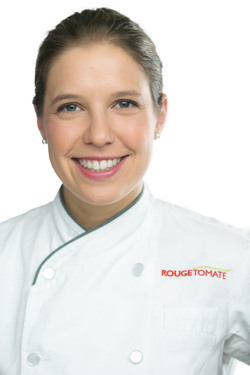 After studying history in college, Kristy Del Coro’s passion for food and nutrition led her to pursue her M.S. in Clinical Nutrition from NYU. Armed with her Registered Dietician credential, she still longed to enhance her culinary skills. So, while working as a clinical dietician at a cancer center she enrolled in night classes to acquire her Culinary Arts degree. Now, as the Senior Culinary Nutritionist at Michelin-starred Rouge Tomate in New York City, she has the ability to combine her unique skillset to work hand-in-hand with the chefs to ensure the dishes are just as healthy as they are delicious.
After studying history in college, Kristy Del Coro’s passion for food and nutrition led her to pursue her M.S. in Clinical Nutrition from NYU. Armed with her Registered Dietician credential, she still longed to enhance her culinary skills. So, while working as a clinical dietician at a cancer center she enrolled in night classes to acquire her Culinary Arts degree. Now, as the Senior Culinary Nutritionist at Michelin-starred Rouge Tomate in New York City, she has the ability to combine her unique skillset to work hand-in-hand with the chefs to ensure the dishes are just as healthy as they are delicious.
KELLY HENSEL: You got your undergraduate degree in history. What prompted you to pursue both an M.S. in Clinical Nutrition and your Culinary Arts degree?
KRISTY DEL CORO: When I started college—like most college students—I didn’t know what I wanted to do. One of my advisors told me to pick something that I love. I had a love for history and didn’t really think about what I was going to do with it later, but decided to pursue that as my field of study because at least it was something that interested me. While I was pursuing that major, I started to become more interested in the food world and was taking recreational cooking classes and cooking for my roommates. I was also reading a lot of health magazines. It started as a hobby.
And then a couple of people started to comment on how passionate I was about food and nutrition and health and I think a friend said “why don’t you go into that as a career?” So, when I started to look into that it was too late for me to switch my major but I did take an introductory nutrition class as part of the nursing school that they have there [Boston College]. I realized that it was something I wanted to turn into a career. However, I was torn between culinary school and nutrition because I didn’t want to just work in a hospital—I didn’t want to be overly clinical. I wanted to work with food but didn’t necessarily want the lifestyle of a chef.
So I decided to pursue my Masters first and went to NYU because they had more of a food focus. Different nutrition programs have different areas of focus and at NYU they offered an introductory cooking class and they had a whole food study department. I ended up working in a hospital after my training just to get that solid foundation but still kept thinking about food and that whole culinary side. I wanted to use my skills in a more hands-on way. So that’s when I decided to pursue culinary school after NYU.
HENSEL:After you got your RD, you got a job as an Outpatient Clinical Dietician at Memorial Sloan Kettering Cancer Center. I imagine you had some great experiences there, but was it very clinical?
DEL CORO:It was, but I was actually dealing with people who were going through radiation treatment and chemotherapy that had trouble maintaining their weight. So we would talk a lot about food even though it was very clinical. Because it was outpatient, we would have a lot of interventions with family and talk about recipes and how to get more nutrients into their food. And I worked with the Executive Chef for the hospital to do more outreach with our employees for wellness. We would do cooking demos together. I was always drawn to that so I tried to pursue it even there in a clinical setting but finally just decided to go for it by enrolling in culinary school.
HENSEL: There aren’t many others with your unique education and work experience, leaving you kind of on your own to forge a new path. Who do you admire and look to for inspiration?
DEL CORO: I know that I can’t say I’m the first one to do this. There are a lot of people who have been able to combine these two fields. There are certainly dieticians who have chosen to combine the fields of culinary and nutrition. However, there aren’t a lot of formal programs out there, which is something that I would like to see in the future. It would be great to have more of that culinary nutrition track for dietitians because I think as nutritionists, we talk about food all day long but not all of us really know a lot about what goes into preparing delicious food that’s also healthy.
But there are some nutritionists out there that are combining the two fields—like Ellie Krieger. She used to have that show on the Cooking Channel [Healthy Appetite with Ellie Krieger], which was kind of groundbreaking because it was one of the first healthy cooking shows that actually had a registered dietician as a host.
I know her now too because she lives in New York and one of the dieticians who worked at Rouge Tomate before I came on is good friends with her. She’s one of the people I reached out to as I was getting into this field just to see what her past experiences were and what different opportunities were out there.
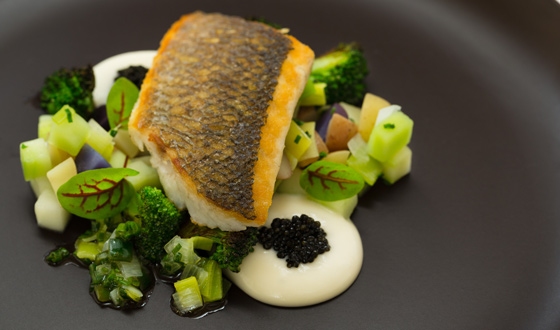
HENSEL: What is your typical day at the restaurant like? How do you work with the other chefs to develop the menu?
DEL CORO: Rouge Tomate’s owner is a Belgium entrepreneur and the whole concept behind this restaurant was to pair a chef and a dietician. So from the very beginning he wanted to break that barrier between fine dining and really delicious food and nutrition. He wanted to prove that you could have healthy and delicious food.
So he worked with the dietician at the time to start to develop this set of guidelines which we call SPE which is from the Latin phrase, Sanitas Per Escam or “health through food.” Now these guidelines have become a charter which is vetted by a third party scientific committee of nutrition experts. At Rouge Tomate I work diligently to make sure our diners are getting at least 40% of their daily value of vitamins and minerals when they eat a three-course lunch or a four-course dinner here. The charter that I work from breaks down each course and then has specific guidelines as far as how many grams of fruits and vegetables should be in an appetizer, how many should be in an entrée, how much added fat can go in an appetizer or an entrée, how much fruit needs to be in a dessert, and so on. So, one of my jobs is to make sure that before a dish goes on the menu it meets those criteria.
One of the primary objectives is to encourage consumption of fruits and vegetables so that’s why we have minimum amounts for how many fruits and vegetables should be in each dish. And we prefer seafood over poultry and poultry over red meat. We also emphasize healthy fats in place of saturated fats.
And we also look at food synergies, and this is where I also work with the chef. For example, one of the nutrients that we aim to balance is sodium and potassium. Sodium is something we want to limit, but in a restaurant and in any type of cooking, you need salt to enhance flavor. When we’re examining at a dish and putting together the nutrition analysis, we want to balance sodium with high potassium ingredients because potassium can counteract the negative effects of sodium in your body. So I work with the chefs and say, “Okay, you’re using capers in this dish or shellfish, which is naturally high in sodium.” Then we will reference a list of seasonal ingredients that are high in potassium and see if any of them make sense to include in the dish.
For vegetarian dishes it’s important to evaluate the specific nutrients that are difficult to get in a vegetarian or vegan diet. One of those is iron. So it’s one thing to say okay, let’s try to pick foods high in iron. But in order for your body to properly absorb iron at its full potential from plant foods, you need to combine it with foods high in vitamin C. So when the chef is putting together a vegetarian dish, we’ll keep those two nutrients in mind.
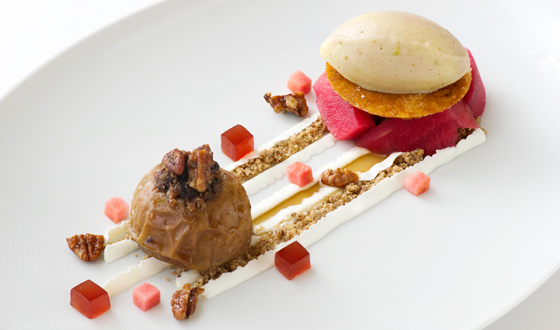
HENSEL: And you work with the pastry chef in the same way?
DEL CORO: We don’t use any butter or cream on our appetizer/entrees but we do use limited amounts in dessert. However, there’s still a challenge to get that mouthfeel, texture, and completeness without excessive amounts of added sugar. It’s also challenging to get enough fruit on the plate without it just looking like a fruit plate. So the chefs are really creative and incredible at that. And sometimes they’ll come to me with a recipe and it’ll be great right off the bat because they’ve been doing it for a long time. At other times, I might say “well, it’s a little bit high in saturated fat coming from the coconut milk, sugar, or the heavy cream that you’ve used, so how can we tweak that?” Then we’ll examine the recipe and he may ask “what if I swap out whole milk for the cream? How much of a difference does that make?” And then I can use the software I have and tell him if that would be a significant enough difference.
HENSEL: Since the focus of the food at Rouge Tomate is on seasonal ingredients, how often does the menu change? Are you at the restaurant on a regular basis, or just when new menu items are developed?
DEL CORO:We change a lot here. Not just because we’re so seasonal but it’s kind of the nature of the restaurant. We also have a lot of regulars and we like to keep things interesting and change things up a lot. So I am here every day.
I’m more involved with the prep and putting the dishes together, especially when they first go on the menu. I see how the dishes are coming together and how everything is being prepared. For the actual service, that’s when I take time to work on the nutritional menu descriptions for the front of house staff. For example, we have allergy charts that we post everywhere. I also make phone calls during that time. So I’m not involved in the actual service. But I’m definitely very comfortable in that environment. All of the cooks know me well and I’m down there a lot. I’m just not actually responsible for working on the line.
HENSEL: Is nutrition information for each dish posted online?
DEL CORO: It’s on the SPE Certified website. And we also have it available upon request in the restaurant.
SPE is like a certification and consulting company that is owned by the same person that owns Rouge Tomate. SPE works with other foodservice establishments to certify their dishes meet the guidelines set out in the charter. So, on the SPE Certified website each restaurant has its own page. When you click on Rouge Tomate, you’ll see our current menu and old dishes and then you can click on each dish and that gives you the nutrition breakdown.
You’ll notice the website says that Rouge Tomate is technically not SPE Certified. That’s because we have the same owner, so it’s just a legal issue. We can’t self-certify. But all of our dishes fully apply the SPE principles.
I just started doing a little more work on the consulting side with SPE. We have started to focus on individualized consulting work, recipe development, nutrition analysis, and allergy identification on a case-by-case basis. So I’m technically the Senior Culinary Nutritionist of both Rouge Tomate and SPE Certified. But we have a whole team at SPE—I’m not the only one.
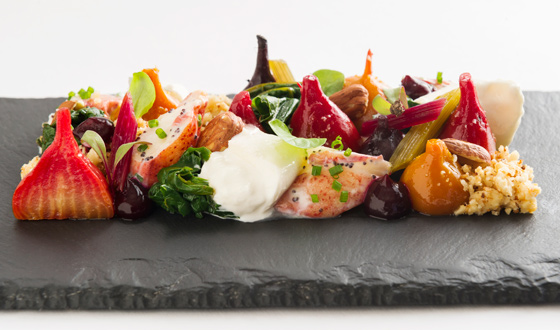
HENSEL: In addition to nutrition, Rouge Tomate focuses on locally-sourced ingredients. This has become kind of a buzz word in the restaurant industry, so how do you and the other chefs approach it to make it unique and authentic?
DEL CORO: SPE is primarily a nutritional charter but as part of that sourcing as local is possible is more nutritious as well. In the winter it’s challenging so we’ll try to source as local as we can. A lot of farmers will have storage crops that we can buy from or we may have to go to Maine or Massachusetts for seafood. It’s not always right off of Long Island, but we will purchase from Long Island if it’s available.
With something like seafood, we really are considering a lot of factors that go into sustainability like the catch method, the species, where it was landed, and the management of the fisheries. So, it’s not always local because we are taking into account the complete picture and making sure that it’s sustainable.
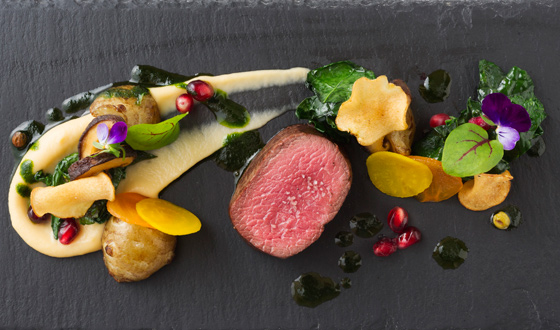
HENSEL: You have been quoted as saying that “Like nose-to-tail cooking with meats, our focus is using all parts of fruits and vegetables to achieve different flavors, textures, and maximum nutrition.” How are you working with the chefs to make veggies and fruits interesting and exciting?
DEL CORO: I think other chefs are probably doing this as well. Maybe not because they are thinking about how to get more vegetables on the plate but just to minimize waste and be more sustainable. Since we don’t use butter or cream and we have these rich heavy sauces in our dishes, a lot of the times we will use vegetable purees as a base or make a vegetable stock, like a cauliflower stock and then emulsify in a cauliflower puree and maybe add some olive oil. That then becomes our sauce. That’s one way to get vegetables into the dish.
We also make a lot of vinaigrettes, which for us are fruit or vegetable based. For example, in the summer we make this peach ginger vinaigrette. We will take the peaches and cook them down with ginger and champagne vinegar and then blend that with oil, such as pecan oil, and that’s a vinaigrette for the salad. So, you’re getting fruit in the vinaigrette rather than just the oil and vinegar.
HENSEL: You were just named as one of FSR magazine’s 40 under 40 at the age of 30 and you call your job your “dream job.” So what’s next for you? Where do you hope to be in your career by 40?
DEL CORO: Right now, I just love what I’m doing so I’m taking it as it comes. I think what I’ve enjoyed about doing more work with SPE Certified is that I have a larger reach. So I think that would be my long-term goal—just to be able to teach more people how to cook healthy and delicious food and to get back into cooking for themselves.
I also enjoy reaching out to children. We partner with a public school here as part of the Wellness in the Schools program. I go into the school once every other month to work with the liaison there and do cooking classes. Recently, we did one on carrots and I showed the kids how to make braised carrots. That’s the kind of stuff that I enjoy and luckily get to do as part of my current job.
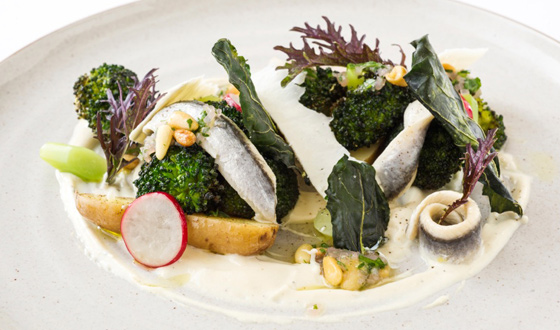
Recipe: Roasted Broccoli & Marinated Potato Salad
By: Rouge Tomate's Senior Culinary Nutritionist Kristy Del Coro and Executive Chef Jeremy Bearman
Roasted Broccoli
1.5 lbs broccoli, cut into “trees” so some stem is still attached
2.5 tbsp olive oil
1/4–1/2 tsp of red chili flake (adjust according to your desired level of spice heat)
1/2 tsp fine sea salt
zest from 1–2 lemons
Preheat oven to 400°F. Toss broccoli florets with olive oil, grated garlic, chili flake, and salt. Transfer to sheet pan and arrange in a single layer. Roast for about 10 min or until ends florets starts to brown. Remove from oven and toss with lemon zest.
Roasted Garlic Aioli
1 pkg firm tofu, drained
3/4 tsp mustard powder
1 tbsp Dijon mustard
1/4 cup lemon juice (juice from 1.5 lemons)
about 7 cloves roasted garlic *roast extra to use for infused yogurt
1 very small raw degermed garlic clove
5 tbsp rice vinegar
1/2 cup grapeseed oil
3/4 tsp fine sea salt
ground black pepper to taste
Add all ingredients except for oil into blender. Start to blend and then emulsify in oil. Blend well to remove any gritty texture from tofu until smooth consistency. Check seasoning and adjust if necessary. (Yields 3 cups so you will have leftover but difficult to scale this recipe down in order to blend properly.)
Marinated Fingerling Potatoes
11 lb fingerling potatoes
1–2 shallots, finely minced
thyme
extra virgin olive oil
fleur de sel
cracked black pepper
Add potatoes to pot and cover with cold water. Add 1 halved head of garlic and a few sprigs of thyme for extra flavor. Gently cook potatoes on low heat until fork tender. When potatoes are cooked, cool in refrigerator and drain from liquid.
To marinate, cut each fingerling potato in half lengthwise and lay on sheet tray or baking pan in single layer, flesh side up. Drizzle with good extra virgin olive oil and top with finely minced shallot, picked thyme (enough to get a few pieces of thyme on each potato), fleur de sel, and cracked black pepper to taste. Cover with plastic wrap and let marinate for about 30 min.
These will store well in refrigerator once covered with plastic wrap but make sure you let them come back up to room temperature before serving.
Pine Nut Shallot Vinaigrette
3/4 cup minced shallot
6 fl oz rice vinegar
pine nut oil
lemon oil
Combine minced shallot and rice vinegar in pot and heat on high. Cook quickly, stirring frequently to prevent from burning until liquid has almost completely evaporated but shallots are not completely soft (they should still have some texture and not be mushy). Measure volume of cooked shallots and add equal parts pine nut oil and lemon oil. Season with pinch of salt and refrigerate.
Broccoli Leaf Chips
2 large Broccoli leaves, stems removed (or Tuscan kale if broccoli leaves are unavailable)
Olive oil
Sea Salt
Preheat oven to 250°F. Cut broccoli leaves into 2-inch squares and gently toss with olive oil—just enough to lightly coat—and pinch of sea salt. Bake on sheet tray with a rack for 12–15 min, rotating halfway through until leaves are crispy like chips.
Roasted Broccoli & Potato Salad (for 4)
1/4 cup Roasted Garlic Aioli
16–20 pieces Roasted Broccoli (should be yield from recipe above)
12 Marinated Fingerling Potato halves
1/4 cup Pine Nut Shallot Vinaigrette*
1 oz ricotta salata, shaved with vegetable peeler
2 ea. raw red radish, sliced into thin rounds
12 ea. boquerones anchovies (optional)
12 ea. broccoli leaf chips
* Immediately before serving, take 1/4 cup pine nut shallot vinaigrette and stir in 1 tbsp chopped parsley, and 1.5 tbsp toasted pine nuts and stir to combine.
To plate salad, spread thin layer of 1 tbsp roasted garlic aioli on bottom of each plate. Arrange 4–5 pieces roasted broccoli stems, 3 potato halves, and a few pieces of radish on top of aioli. If using anchovies, arrange 3 pieces anchovy on plate as well. Drizzle each plate with 1 tbsp pine nut shallot vinaigrette and top with thinly shaved ricotta salata and a few broccoli leaf chips.


